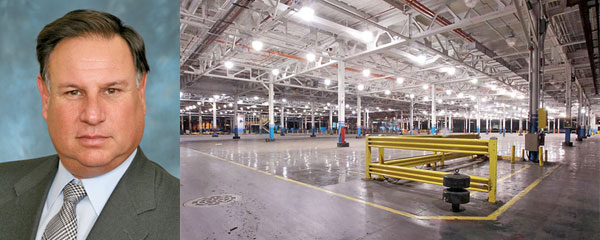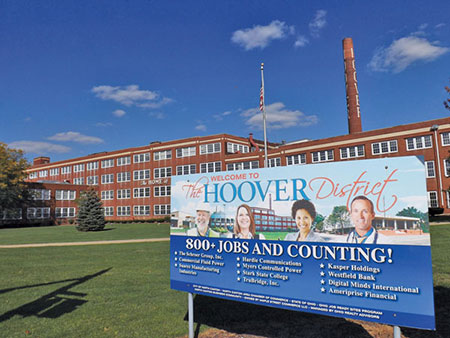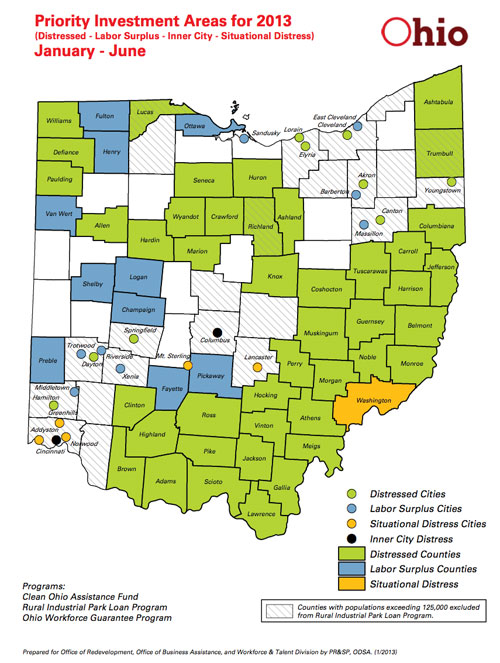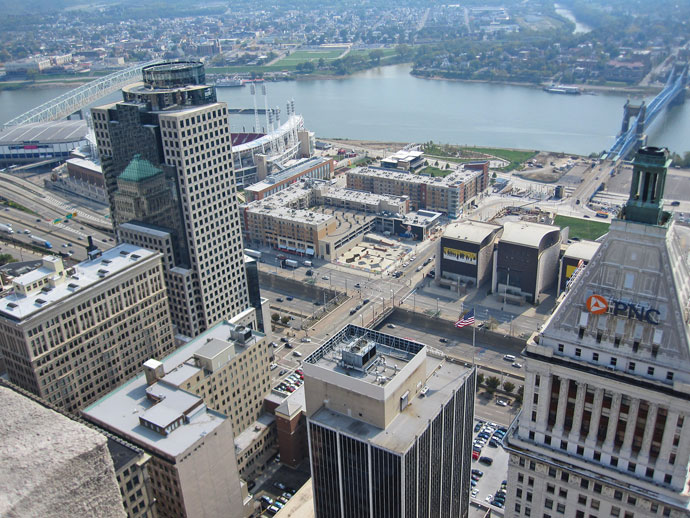In Site Selection’s annual sustainability rankings in 2012, Ohio ranked in the top dozen states in the country for federal brownfield funding. That’s because, in part, it’s a state that has its share. But it’s also because there’s a typically Ohioan drive to do something about them.
With the reorganization of such agencies as JobsOhio and the recent removal of red tape at the state level by the state’s renamed Clean Ohio Council, that motivation is kicking into overdrive, with gratifying results for all concerned.
Last August, the RACER (Revitalizing Auto Communities Environmental Response) Trust — created to clean up and position for redevelopment properties and other facilities owned by the former General Motors Corp. before its 2009 bankruptcy — announced it had entered into an agreement to sell the former GM Mansfield-Ontario Stamping Plant in Ontario, Ohio, to the Brownfield Communities Development Company (BCDC), which has committed to bringing more than 1,100 new jobs to Ohio.
“This facility served as an economic engine for the community for 55 years under GM,” said RACER Trustee Elliott P. Laws. “The agreement with BCDC sets the stage for a new era of economic vitality on this property. We envision the creation of 1,100 new jobs as a transformative event for the entire region. We are delighted for the Ontario/Mansfield community and for Ohio. This agreement is the product of a dedicated partnership of federal, state and local officials who were determined to bring new economic activity to this region.”

Michael Adler, chairman and CEO, Adler Group Inc., is excited for the future of the former GM Mansfield plant in Ontario, Ohio, shown here at the time of its sale last August.
BCDC envisions a modern corporate park on the site, and already had identified two tenants that were interested in occupying much of the 2.5- million-square-foot building that sits on 266 acres just west of Mansfield in Richland County. BCDC is a joint venture of Adler Group Inc., a Miami, Fla.-based firm with more than 50 years of leasing, property management, acquisitions, investment, development and construction experience, and Hilco Real Estate, a strategic advisory and consulting services real estate firm based in Northbrook, Ill.
“We’re delighted to have reached this agreement, and look forward to being part of the revitalization of this wonderful site,” said Michael M. Adler, chairman and CEO of Adler Group. “Mayor Collins and the people of Ontario and Richland County have partnered with us from day one, and everything we have seen confirms that this is a terrific investment.”
Ontario Mayor Larry Collins said his community worked closely in cooperation with RACER staff to ensure prospective developers understood the benefits of operating in the former GM plant, which was idled in 2010.
“The addition of 1,100 private-sector jobs is a historic event for our community,” he said last August. “Ontario understands business, and we work every day to ensure business owners and developers see the tremendous opportunities that exist here.”
“The Ontario and Mansfield communities have waited for years for good news regarding the former GM site,” said U.S. Senator Sherrod Brown, a native of Mansfield.
Ready to Move
RACER is one of the largest holders of industrial property in the United States and is the largest environmental response and remediation trust in U.S. history. When the Trust was formed, it owned 89 properties in 14 states, principally in the Midwest and Northeast. The Mansfield-Ontario Stamping Plant was the 17th former General Motors location sold since the RACER Trust was established in March 2011. Total sales proceeds through last August exceeded $24 million.
“There is not a community in America that would not welcome this news with elation,” Laws said. “But I know it is especially welcome news here, where the impact of previous job losses is still felt so deeply in so many families. We look forward to the day when this facility once again will stand as an economic beacon for Ontario and the surrounding communities of Richland County.”

Columbus and Franklin County Metropolitan Park District was awarded a Clean Ohio Assistance Fund grant for asbestos abatement, demolition, and remediation at the Lazarus Warehouse property, which has an industrial history dating back to the late 1800s. Prior to the construction of the Lazarus Warehouse in 1946, Franklin Furnace, a steel foundry, and later, a sand and gravel mining operation were located on the property. Remediation is complete and the property, located in the city’s Brewery District, is part of a larger development of the Scioto Audubon Metro Park. The park includes a climbing wall, sand volleyball courts and a boat ramp among other amenities.
Michael Adler says it’s been smooth sailing so far at what is now called Ontario Business Park, including the follow-up announcement early this year of the first tenant, Sunfest Organic Herbs. He says RACER’s properties and mission align with his own firm’s focus on the redevelopment of communities, not just parcels.
“We’ve looked at a lot of properties that the RACER Trust owns,” he says. “This one had particular interest because we had quite a few companies we thought we could relocate or locate in this location. One was a farming company based in Okeechobee, Florida called Sunfest, which has a significant business of selling herbs, and wanted to expand into the Midwest. They needed a location for distribution, packaging and growing. We were able to enter into a contract with them to open a location.”
“Based in Florida, Sunfest has flourished as a growing, packing, and shipping for the purest herbs conceivable,” said Clifford Rosen, president and CEO, Sunfest Organic Herbs. “We are looking forward to the many benefits of expanding our business into the Midwest including transportation and supply chain advantages, new market opportunities and access to our customer base.”
Adler says he’s in talks with several other users he can’t talk about just yet.
“We believe the best utilization isn’t to have a single company like GM, but turn it into a corporate park with a significant number of users, which will make it a diversified business community,” he says. “It will be healthier because it’s not dependent on one company but multiple companies.”
Bruce Rasher serves as redevelopment manager for RACER Trust, and also is the chairman, president and CEO of the National Brownfield Association.
“In many respects, this has been an ideal transaction for the Trust,” he says, in terms of the mission to revitalize places and to return properties to productive use. “We had a close working relationship with the City of Ontario, Richland County and with the State of Ohio, including both the environmental department and development department. We were very impressed by how responsive the state was, and how well coordinated the two departments operate. They are deal- and customer-oriented, and it was a pleasure.”

This former Hoover property in North Canton has benefited from state Job Ready Sites funding, among other funds, and has already seen new business locations because of it.
The Trust has sold two other large plants in Ohio — one in Parma and another in Lorain. “Both of those developments are going extremely well,” says Rasher, noting that the Trust is still marketing vacant industrial land in Lordstown and in Toledo. “We also have a property in Elyria” in Lorain County, he says, that “has attracted interest from potential solar developers. We have not able to conclude a deal yet, but we have seen interest from various parties in a solar reuse.”
Adler echoes Rasher in his praise for the government’s approach.
“Ohio should be proud of the way it’s responding in these economic times,” he says, noting the “amazing” impediments some territories throw in the way of opening a business and getting approvals. “No question there has been a high level of cooperation. There is definitely a sense that ‘We need to get things done and get things done in an expedited fashion.'”
Case Study in Streamlining
The Clean Ohio Council recently announced a streamlined process for funding brownfield projects. The process creates a single brownfield incentive program, combining Clean Ohio’s Revitalization Fund and Assistance Fund, which will be managed through a collaboration of the Ohio Development Service Agency’s Office of Redevelopment, JobsOhio and the Clean Ohio Council. All brownfield project requests will begin with JobsOhio and its regional network partners.

Erected in 1921 in Cincinnati’s Northside neighborhood, the American Can Building is significant for its historical association with one of the nation’s largest can manufacturing companies. The $22-million restoration of the property benefited from state brownfield revolving loan funds, and is the central component of the Factory Square project, which includes nearly 100 loft apartments, retail space in the former loading bays, and newly constructed townhomes and office space.
“This new structure will streamline the process for communities interested in Clean Ohio assistance,” said Christiane Schmenk, director of the Ohio Development Services Agency, in March. “As we transition into this new model, our commitment remains the same. We want to provide outstanding customer service, create jobs and build strong communities making Ohio a place everyone can succeed.”
Clean Ohio funding assists projects in environmental assessment, acquiring property, demolishing structures, conducting environmental cleanup and improving infrastructure. Funding requests will be accepted by JobsOhio and its regional network partners, who will then evaluate a project’s economic benefits. Clean Ohio grant recommendations will then be referred to the Director of the Development Clean Ohio Council for review and potential approval.

This map from the Ohio Office of Redevelopment, while portraying economic distress, can just as easily be interpreted as a picture of opportunities, especially when taking into account labor surpluses and brownfield sites.
In addition to the streamlined process, the Council announced that grant funding will be available on a rolling cycle, as opposed to having specific funding rounds. Up to $3 million will be available per project for cleanup activities and $200,000 per project will be available for environmental assessment activities. Additional brownfield funding is available through the Brownfield Loan Program, which is administered by the Ohio Development Services Agency’s Office of Redevelopment.
JobsOhio is accepting funding requests for the $15 million grant allocation. Funding may include a grant and loan combination, utilizing the brownfield grant funding and the Brownfield Loan Program.
In April the City of Geneva learned that the Clean Ohio Council had approved a “long anticipated” grant of $388,455 to complete soil remediation to allow for a future 24,000-sq.-ft. plant expansion. The Arthur Louis Steel Company (ALS) has been in the steel fabrication business for over 60 years and specializes in supply of structural and miscellaneous steel for industrial projects. ALS has provided fabricated steel to projects located in 40 states and 17 countries worldwide and employs 67 staff at three Ohio locations. Their headquarters located in Ashtabula and their manufacturing facility had undergone four expansions since 1995 and was at a point where they were unable to expand any further due to being landlocked.
In 1997 ALS purchased the former Corespan Building in Geneva within the True Temper complex. ALS was seeking to expand manufacturing space to meet the demand.
“A logical location to expand is on the neighboring vacant 11 acres, except for the simple fact that the surrounding property had a legacy of environmental contamination,” explains a release from the City of Geneva. “Previously the Geneva Tool Co. owned this property and began manufacturing farm implements. It was eventually purchased by True Temper. The site has been used for a variety of purposes, dating back to 1885. Prior to 1950, the site was used primarily for manufacturing, including the production of tools, fishing rods and golf clubs. From 1950 to 1980, the inclusion of metal plating was added to the manufacture of sports equipment. True Temper eventually closed in the 1980s.”
Case Study in Patience
The city in August 2008 applied and successfully received a VAP phase 1 grant to evaluate the environmental conditions of the property. The study indicated the need for a phase II. The city received a federal site assessment grant to hire a consultant to perform a comprehensive evaluation and assist in obtaining Clean Ohio Assistance Funds to perform the Phase II. The city completed the Phase II in 2012. These latest grant proceeds are the final step in the process. ALS’s Geneva location will retain 12 employees and proposes to expand its staff by 10 additional members. The total project investment is estimated at $1.8 million, including that includes site clean-up activities, acquisition of land, construction of new building and purchase of equipment.
“I’m most appreciative of both Matt and JT Kanicki, owners of Arthur Louis Steel, with putting their faith in the City of Geneva in securing grant funds for the clean-up efforts,” said Jennifer Brown, assistant city manager.
“Without the hard work and commitment of the City of Geneva and in particular Jennifer Brown, this project would have never been possible,” said Matt Kanicki, ALC vice president. “This investment demonstrates our commitment to our employees, the City of Geneva, Ashtabula County and also represents what is possible when local government and businesses partner together.”
